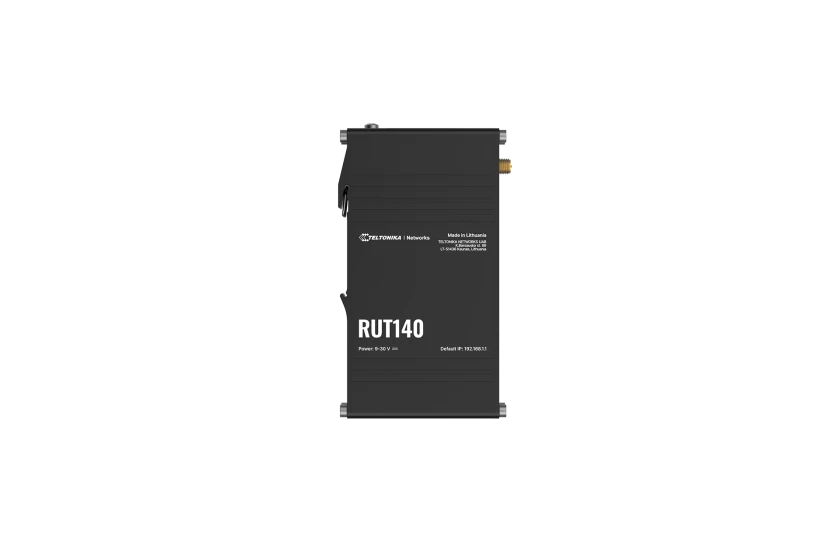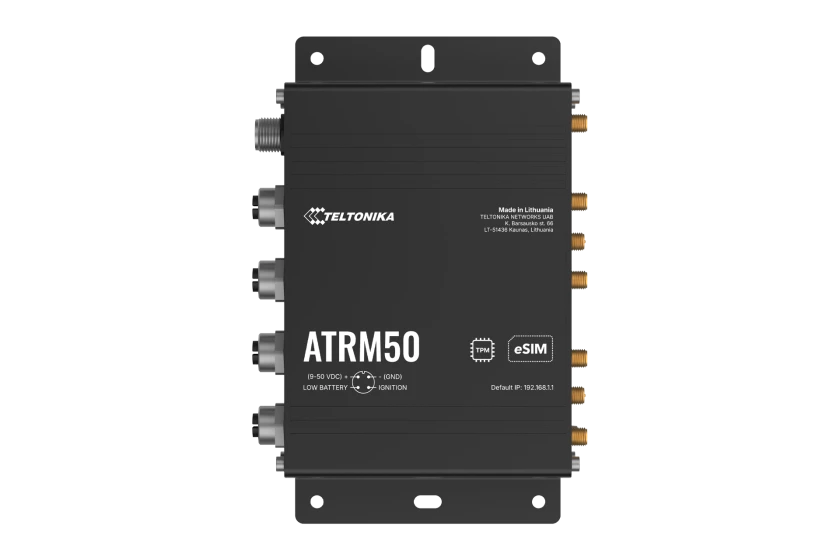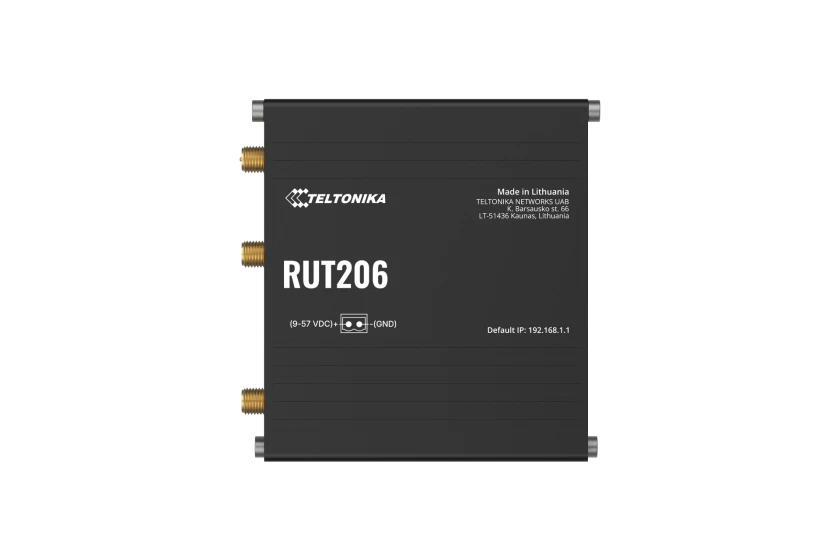
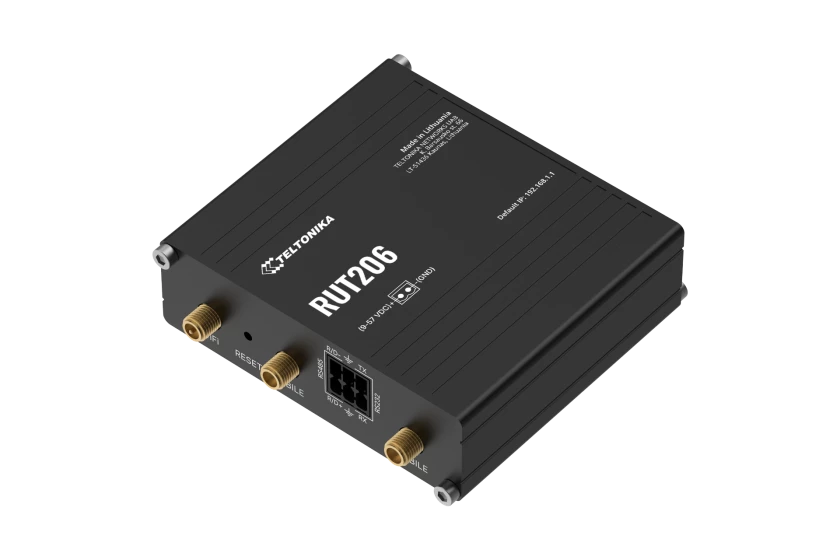
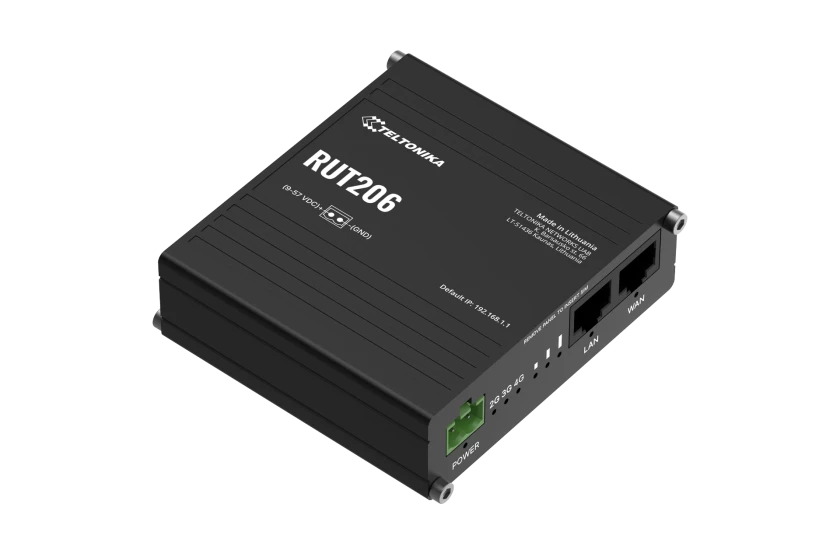
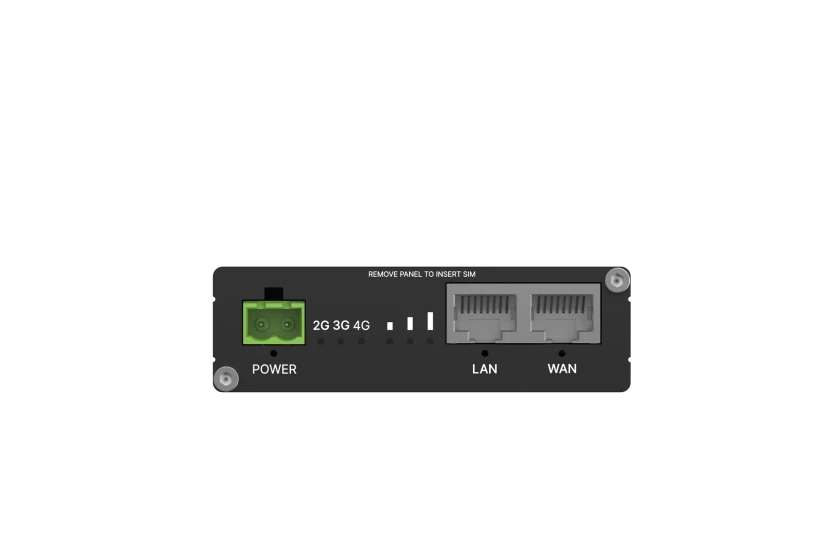
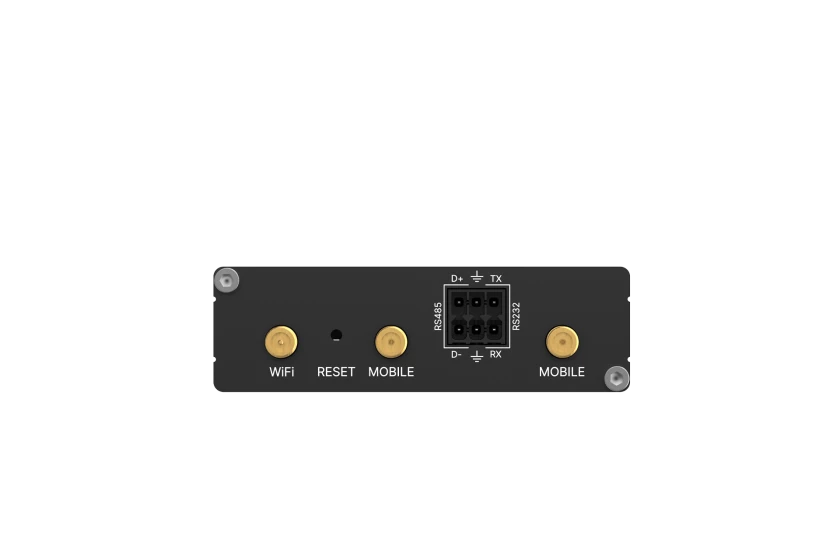
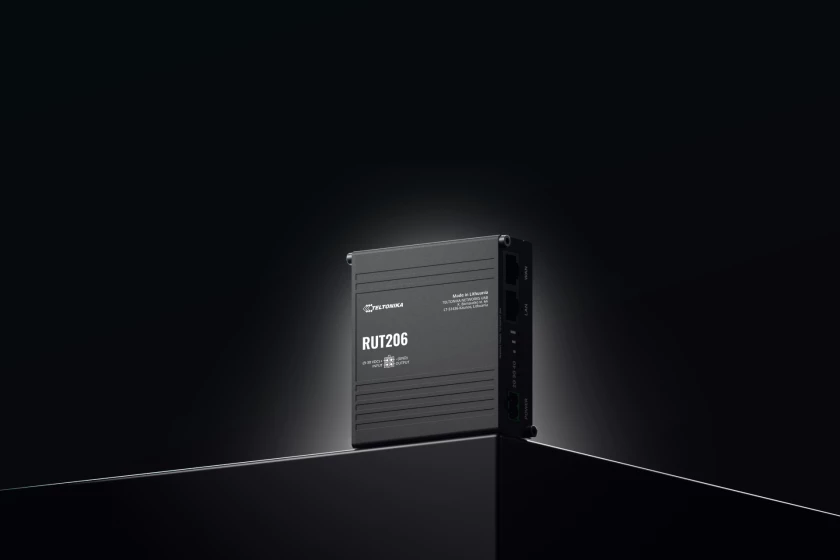
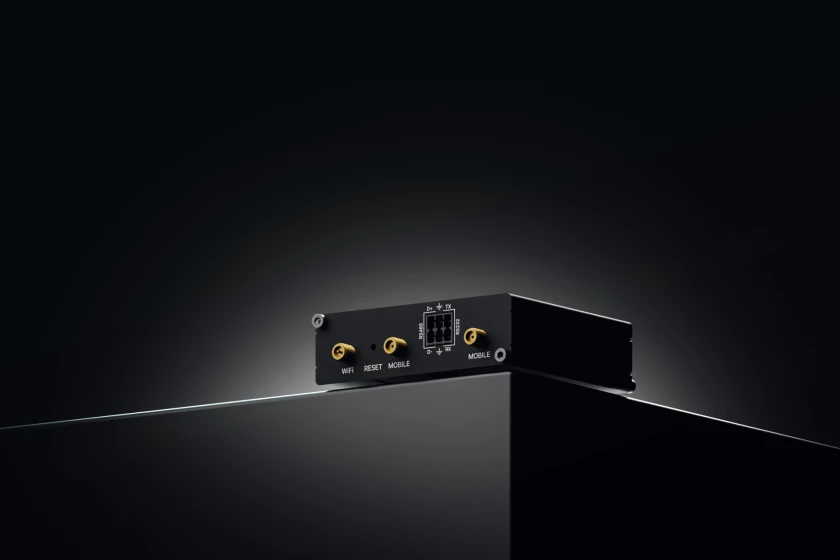
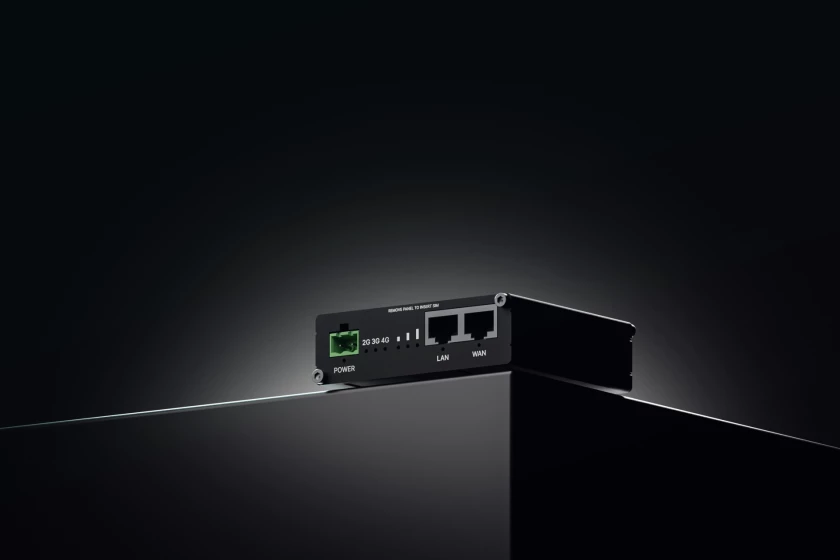
RUT206
The RUT206 is a compact industrial router that supports RS232 and RS485 serial interfaces, along with both active and passive PoE inputs. Its rugged design, 2-pin power input, and expandable data storage via a microSD slot make it an ideal choice for a range of IoT and M2M applications. This 4G Cat 4 router comes with RutOS open-source software and supports key industrial protocols like Modbus, DNP3 and DLMS.
MOBILE MODULE
The device supports 4G LTE Cat 4 with download speeds up to 150 Mbps and upload speeds up to 50 Mbps. 3G connectivity offers up to 21 Mbps downlink and 5.76 Mbps uplink. 2G connectivity supports up to 236.8 kbps for both download and upload.
3GPP RELEASE
Release 9.
SIM SWITCH
Supports 2 SIM cards with automatic switching. Switch triggers include weak signal, data limit, SMS limit, roaming, no network, network denied, data connection failure, and SIM idle protection.
STATUS
Status reporting includes IMSI, ICCID, operator, operator state, data connection state, network type, bandwidth, connected band, and signal strength (RSSI, SINR, RSRP, RSRQ, EC/IO, RSCP). Additional parameters include data sent/received, LAC, TAC, cell ID, ARFCN, UARFCN, EARFCN, MCC, and MNC.
SMS
Features include SMS status, configuration, EMAIL to SMS, SMS to EMAIL, SMS to HTTP, SMS to SMS, scheduled SMS, SMS autoreply, and SMPP.
USSD
Supports sending and reading Unstructured Supplementary Service Data messages.
BLOCK / ALLOW LIST
Operator block or allow list by country or individual operators.
BAND MANAGEMENT
Includes band lock and used band status display.
SIM IDLE PROTECTION SERVICE
Provides the possibility to configure the router to periodically switch to the unused SIM card and establish a data connection to prevent SIM blocking.
SIM PIN CODE MANAGEMENT
Enables setting, changing, or disabling the SIM card’s PIN.
APN
Automatic APN detection and configuration.
BRIDGE
Direct connection (bridge) between mobile ISP and device on LAN.
PASSTHROUGH
Router assigns its mobile WAN IP address to another device on LAN.
WIRELESS
Wireless mode: 802.11b/g/n (Wi-Fi 4), Access Point (AP), Station (STA).
Wi-Fi security: WPA2-Enterprise (PEAP), WPA2-PSK, WPA-EAP, WPA-PSK, WPA3-SAE, WPA3-EAP, OWE; AES-CCMP, TKIP, Auto-cipher modes, client separation, EAP-TLS with PKCS#12 certificates, disable auto-reconnect, 802.11w Protected Management Frames (PMF).
SSID/ESSID: SSID stealth mode and access control based on MAC address.
Wi-Fi users: Supports up to 50 simultaneous connections.
Wireless connectivity features: Wireless mesh (802.11s), fast roaming (802.11r), Relayd, BSS transition management (802.11v), radio resource measurement (802.11k).
Wireless MAC filter: Allowlist and blocklist.
Wireless QR code generator: Once scanned, a user automatically enters the network without needing to input login information.
TravelMate: Forwards Wi-Fi hotspot landing page to subsequent connected devices.
ETHERNET
WAN: 1 × WAN port 10/100 Mbps, compliant with IEEE 802.3, 802.3u, and 802.3az standards, supports auto MDI/MDIX crossover.
LAN: 1 × LAN port 10/100 Mbps, compliant with IEEE 802.3, 802.3u, and 802.3az standards, supports auto MDI/MDIX crossover.
NETWORK
Routing: Static routing, dynamic routing (BGP, OSPF v2, RIP v1/v2, EIGRP, NHRP), policy-based routing.
Network protocols: TCP, UDP, IPv4, IPv6, ICMP, NTP, DNS, HTTP, HTTPS, SFTP, FTP, SMTP, SSL v3, TLS, ARP, VRRP, PPP, PPPoE, UPNP, SSH, DHCP, Telnet, SMPP, SNMP, MQTT, Wake on LAN (WOL), VXLAN.
VoIP passthrough support: H.323 and SIP-ALG protocol NAT helpers, allowing proper routing of VoIP packets.
Connection monitoring: Ping reboot, Wget reboot, periodic reboot, LCP and ICMP link inspection.
Firewall: Port forwarding, traffic rules, custom rules, TTL target customization.
Firewall status page: Displays all firewall statistics, rules, and rule counters.
Port management: View device ports, enable/disable ports, auto-configuration, and transmission speed adjustments.
Network topology: Visual representation of connected devices.
DHCP: Static and dynamic IP allocation, DHCP relay, server configuration, status, static leases with MAC wildcards.
QoS / Smart Queue Management (SQM): Traffic prioritization by source/destination, service, protocol, or port; WMM, 802.11e.
DDNS: Supports >77 service providers; others configurable manually.
DNS over HTTPS: Enables secure DNS resolution via HTTPS proxy.
Network backup: Supports Wi-Fi WAN, mobile, VRRP, and wired options with automatic failover.
Load balancing: Balances Internet traffic over multiple WAN connections.
HOTSPOT
Captive portal with internal/external Radius server, Radius MAC authentication, SMS authorization, SSO authentication, internal/external landing page, walled garden, user scripts, URL parameters, user groups, limitations per user or group, user management, 9 default customizable themes with optional upload/download of custom themes.
HOTSPOT 2.0
Wi-Fi standard for seamless, secure, and automatic connection to trusted networks.
SSHFS
Supports mounting remote file systems via SSH protocol.
TRAFFIC MANAGEMENT
Real-time monitoring, wireless signal charts, and traffic usage history.
SECURITY
Authentication: Pre-shared key, digital certificates, X.509, TACACS+, internal/external RADIUS, IP/login attempts block, time-based login blocking, built-in random password generator.
Firewall: Preconfigured firewall rules via WebUI, unlimited CLI configuration, DMZ, NAT, NAT-T, NAT64.
Attack prevention: DDoS protection (SYN flood, SSH, HTTP/HTTPS), port scan prevention (SYN-FIN, SYN-RST, Xmas, NULL flags, FIN scan attacks).
VLAN: Port and tag-based VLAN separation.
Mobile quota control: Customizable mobile data limit with period, start time, warning limit, and phone number association.
Web filter: Blacklist and whitelist support.
Access control: Flexible control for SSH, Web interface, CLI, and Telnet.
Certificate Manager: Tools for creating CA, server, client, Let’s Encrypt, and SCEP certificates.
802.1x: Port-based network access control server.
VPN
OpenVPN: Multiple clients and server instances, 27 encryption methods.
OpenVPN encryption: DES-CBC 64, RC2-CBC 128, DES-EDE-CBC 128, DES-EDE3-CBC 192, DESX-CBC 192, BF-CBC 128, RC2-40-CBC 40, CAST5-CBC 128, RC2-64-CBC 64, AES-128-CBC 128, AES-128-CFB 128, AES-128-CFB1 128, AES-128-CFB8 128, AES-128-OFB 128, AES-128-GCM 128, AES-192-CFB 192, AES-192-CFB1 192, AES-192-CFB8 192, AES-192-OFB 192, AES-192-CBC 192, AES-192-GCM 192, AES-256-GCM 256, AES-256-CFB 256, AES-256-CFB1 256, AES-256-CFB8 256, AES-256-OFB 256, AES-256-CBC 256.
IPsec: XFRM, IKEv1, IKEv2, 14 encryption methods (3DES, DES, AES128/192/256, AES128GCM8/12/16, AES192GCM8/12/16, AES256GCM8/12/16).
GRE: GRE tunnel and GRE over IPsec support.
PPTP, L2TP: Client/server instances, L2TPv3, L2TP over IPsec.
Stunnel: Adds TLS encryption to existing clients/servers.
DMVPN: Phase 2 and 3, dual hub support.
SSTP, ZeroTier, WireGuard, Tinc: Client and server support with encryption, authentication, and compression.
INDUSTRIAL PROTOCOLS
BACNET: Router mode, RS485 and TCP.
OPC UA: Client and server mode, TCP.
MODBUS: Client/server, RTU and TCP, custom register blocks.
Supported data formats: 8-bit INT/UINT, 16-bit INT/UINT, 32-bit float/INT/UINT (big/little-endian), HEX, ASCII.
DATA TO SERVER: HTTP(S), MQTT, Azure MQTT, with parameter extraction and custom LUA scripting.
MQTT Gateway: Modbus MQTT Gateway for command/data exchange.
DNP3: TCP master, DNP3 outstation; RS232, RS485, TCP.
DLMS/COSEM: Client mode, TCP.
API
Teltonika Networks Web API (beta) for data retrieval and control.
MONITORING & MANAGEMENT
WebUI: HTTP/HTTPS for status, configuration, firmware updates, logs, and troubleshoot.
FOTA: Firmware update from server with automatic notifications.
SSH: Versions 1 and 2.
SMS: Status and configuration.
Call control: Reboot, mobile data on/off, output on/off, answer/hang-up with timer, Wi-Fi on/off.
TR-069: Supports OpenACS, EasyCwmp, ACSLite, tGem, LibreACS, GenieACS, FreeACS, LibCWMP, Friendly Tech, AVSystem.
MQTT: Broker and publisher.
SNMP: v1, v2, v3 with traps and brute-force protection.
JSON-RPC: Management API over HTTP/HTTPS.
RMS: Teltonika Remote Management System.
IoT PLATFORMS
ThingWorx: Monitor WAN type, IP, mobile operator, signal strength, network type.
Cumulocity: Monitor device model, revision, serial, WAN/IP, cell ID, ICCID, IMEI, operator, signal strength; supports reboot and firmware upgrades.
Azure IoT Hub: Data to Server integration, direct method support, zero-touch device provisioning.
AWS IoT Core: API interaction via AWS Jobs.
SYSTEM CHARACTERISTICS
CPU: Mediatek 580 MHz, MIPS 24KEc.
RAM: 128 MB DDR2.
FLASH STORAGE: 32 MB NOR Flash.
FIRMWARE / CONFIGURATION
WebUI: FW updates, configuration profiles, backup.
FOTA: Firmware updates.
RMS: Multi-device update.
Keep settings: Update FW without losing configuration.
Factory settings reset: Full reset restores all system settings.
FIRMWARE CUSTOMISATION
Operating system: RutOS (OpenWrt-based Linux OS).
Supported languages: Busybox shell, Lua, C, C++.
Development tools: SDK with build environment.
GPL customization: Create custom firmware and web UI.
Package Manager: Install additional software.
SERIAL
RS232: Interface without flow control.
RS485: Half duplex (2-wire).
INPUT / OUTPUT
Events: Email, RMS, SMS.
SD CARD
Physical size: Micro SD.
Applications: Samba share.
Capacity: Up to 2 TB.
Storage formats: FAT32, NTFS, ext2, ext3, ext4.
POE IN
PoE ports: 1 × PoE In.
PoE standards: Active PoE input 802.3af Class 0 (12.94 W) on LAN port.
POWER
Connector: 2-pin industrial DC power socket.
Input voltage range: 9–57 VDC, reverse polarity and surge protection (>58V @10 μs min).
PoE (passive): Passive PoE over spare pairs 4,5 (+) / 7,8 (-), voltage 16–57 VDC.
Power consumption: Idle <2 W, Max <3.5 W.
PHYSICAL INTERFACES
Ethernet: 2 × RJ45 10/100 Mbps.
Status LEDs: 3 × connection type, 3 × connection strength, 2 × LAN, 1 × power.
SIM: 2 × Mini SIM (2FF), 1.8V/3V, double stacked.
Power: 1 × 2-pin power connector.
Antennas: 2 × SMA (mobile), 1 × RP-SMA (Wi-Fi).
RS232, RS485: 1 × 6-pin terminal block.
Reset: Reboot/user default/factory reset button.
PHYSICAL SPECIFICATION
Casing material: Anodized aluminum.
Dimensions (W × H × D): 83 × 25 × 83 mm.
Weight: 132 g.
Mounting options: DIN rail, wall mount, flat surface (additional kit required).
OPERATING ENVIRONMENT
Temperature: -40 °C to 75 °C.
Humidity: 10% to 90% non-condensing.
Ingress protection rating: IP30.
REGULATORY & TYPE APPROVALS
Regulatory: CE, UKCA, CB, RCM, EAC, UCRF.
High-Performance Industrial Cellular Routers
Carrier-grade throughput and low-latency routing for enterprise IoT, M2M telematics and critical connectivity.
Industrial-Grade Reliability & Durability
Rugged hardware and tested tolerance to extreme temperature, vibration and electrical noise for continuous operation.
Seamless Failover & Multi-WAN Connectivity
Dual SIM/eSIM, Ethernet redundancy and smart routing ensure uninterrupted service and automatic carrier failover.
Enterprise Security & Managed Network Support
Hardened firmware, VPN/MPLS support and professional managed services to protect data and simplify deployments.

